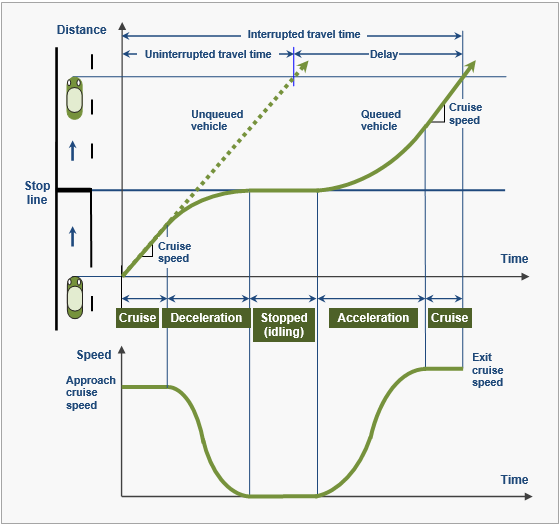SIDRA INTERSECTION Model for Fuel Consumption and Emissions
The vehicle paths (drive cycles) generated by SIDRA INTERSECTION using the four-mode elemental model are very different for different intersection types (signalised, roundabout, sign-controlled), for different signal phasing and signal timing arrangements, and for different congestion levels.
Fuel consumption and emissions are calculated by movement class as applicable to Light Vehicles, Heavy Vehicles, Buses, Large Trucks and up to six user-defined classes.
Vehicle paths (drive cycles) are defined by the initial and final speeds in each element of the driving manoeuvre. Approach and exit cruise speeds, intersection negotiation speeds, queue move-up speeds and acceleration and deceleration times and distances estimated using a polynomial acceleration model are used to determine vehicle paths. The fuel consumption and emission models are applied to queued and unqueued vehicles in each lane separately, and then the total values are calculated for all traffic using the lane. The lane-by-lane results are then aggregated to approaches, intersections, routes and networks.
Vehicle paths for unqueued vehicles are constructed accounting for (i) cruise on entry to the approach road, (ii) slow-down to a safe negotiation speed or full stop on the approach to the intersection, (iii) negotiation of the intersection departure area at the safe negotiation speed, (iv) acceleration to the exit cruise speed and (v) cruise on the exit road.
Vehicle paths for queued vehicles account for (i) cruise on entry to the approach road, (ii) major stop or slow down from approach cruise speed, (iii) queue move-ups (repeated stops and starts in the queue), (iv) negotiation of the intersection departure area at the safe negotiation speed, (iv) acceleration to the exit cruise speed and (v) cruise on the exit road.
Once the vehicle travel paths are determined, the fuel consumption and emission values are calculated for each of the four driving elements (modes) for each vehicle path, the results are added together for the entire vehicle path, and aggregate values for movement classes, lanes and approach (turning) movements are determined according to flow proportions of queued and unqueued vehicles.
Powerful and Accurate Models
This model provides highly accurate fuel consumption and CO2 emission estimates for traffic analysis unlike models that simplify traffic information into such aggregate variables as average travel speed or delay and number of stops (three-mode elemental model).
The key to the estimation of fuel consumption and emissions in SIDRA INTERSECTION software is detailed modelling of stop-starts in addition to delays and queues. Accelerations involved in stop-starts are a major cause of fuel consumption and emissions. Readers may be interested to know that stop-start modelling is not included in the US Highway Capacity Manual. SIDRA INTERSECTION software includes consistent modelling of stop-start behaviour of vehicles at intersections of different types including a unique gap-acceptance model by signal analogy as a basis of modelling stop-starts for roundabouts and intersections controlled by stop and give-way (yield) signs.
Click on any of the following keywords to view search results from our Publications section.

